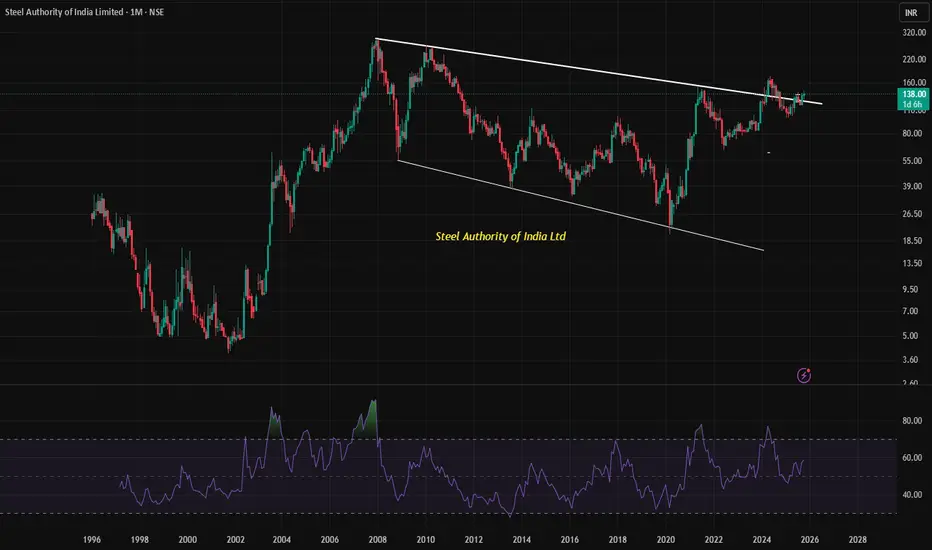SAIL is seen sustaining the breaking out of a 17-year downtrend channel on monthly charts, signaling a potentially powerful long-term reversal.
📈 Steel Authority of India (SAIL): Breaking Free from a 17-Year Technical Grip
Steel Authority of India Ltd. (SAIL), one of India’s largest steel producers, is currently trading around ₹138.80 and showing signs of a major technical breakout. What makes this move noteworthy is that it’s emerging from a downward-sloping channel that has persisted since 2007–2008, spanning nearly 17 years. A breakout from such a long-term pattern is rare and often carries significant implications for future price action.
🔍 Understanding the Downtrend Channel
A downtrend channel is formed when a stock consistently makes lower highs and lower lows, bounded by parallel trendlines. For SAIL, this channel has defined its price movement for over a decade, acting as a ceiling that repeatedly rejected upward momentum. Breaking above this channel suggests a shift in market sentiment—from bearish to bullish.
📊 Monthly Chart Breakout: Why It Matters
Timeframe strength: Monthly chart breakouts are considered more reliable than daily or weekly ones because they reflect long-term investor behavior.
Volume confirmation: Sustained breakout levels often coincide with increased trading volume, indicating institutional interest.
Psychological shift: Surpassing a multi-year resistance level can trigger a wave of buying from traders who were previously cautious.
📈 Technical Indicators Support the Move
According to recent technical analysis:
📊 RSI Confirms Strength
The Relative Strength Index (RSI), a key momentum indicator, is currently moving in the 50–70 range, with recent readings around 58.42. This range is considered a bullish zone, indicating that buying momentum is building without the stock being overbought. Sustained RSI levels above 50 often precede further upward movement, especially when aligned with a breakout.
Price is above both 50-day and 200-day SMAs, reinforcing the strength of the breakout.
These indicators collectively suggest that the breakout is not just a short-term anomaly but part of a broader trend reversal.
🧠 Investor Takeaway
SAIL’s breakout from a 17-year downtrend channel is a textbook example of a long-term technical reversal. With supporting indicators like RSI, MACD, and moving averages aligning in favor of bulls, this move could mark the beginning of a sustained uptrend. Traders and investors may consider this a strong technical setup, but should also factor in macroeconomic conditions and sector fundamentals before making decisions.
Live chart Example
📈 Steel Authority of India (SAIL): Breaking Free from a 17-Year Technical Grip
Steel Authority of India Ltd. (SAIL), one of India’s largest steel producers, is currently trading around ₹138.80 and showing signs of a major technical breakout. What makes this move noteworthy is that it’s emerging from a downward-sloping channel that has persisted since 2007–2008, spanning nearly 17 years. A breakout from such a long-term pattern is rare and often carries significant implications for future price action.
🔍 Understanding the Downtrend Channel
A downtrend channel is formed when a stock consistently makes lower highs and lower lows, bounded by parallel trendlines. For SAIL, this channel has defined its price movement for over a decade, acting as a ceiling that repeatedly rejected upward momentum. Breaking above this channel suggests a shift in market sentiment—from bearish to bullish.
📊 Monthly Chart Breakout: Why It Matters
Timeframe strength: Monthly chart breakouts are considered more reliable than daily or weekly ones because they reflect long-term investor behavior.
Volume confirmation: Sustained breakout levels often coincide with increased trading volume, indicating institutional interest.
Psychological shift: Surpassing a multi-year resistance level can trigger a wave of buying from traders who were previously cautious.
📈 Technical Indicators Support the Move
According to recent technical analysis:
📊 RSI Confirms Strength
The Relative Strength Index (RSI), a key momentum indicator, is currently moving in the 50–70 range, with recent readings around 58.42. This range is considered a bullish zone, indicating that buying momentum is building without the stock being overbought. Sustained RSI levels above 50 often precede further upward movement, especially when aligned with a breakout.
Price is above both 50-day and 200-day SMAs, reinforcing the strength of the breakout.
These indicators collectively suggest that the breakout is not just a short-term anomaly but part of a broader trend reversal.
🧠 Investor Takeaway
SAIL’s breakout from a 17-year downtrend channel is a textbook example of a long-term technical reversal. With supporting indicators like RSI, MACD, and moving averages aligning in favor of bulls, this move could mark the beginning of a sustained uptrend. Traders and investors may consider this a strong technical setup, but should also factor in macroeconomic conditions and sector fundamentals before making decisions.
Live chart Example
Disclaimer
The information and publications are not meant to be, and do not constitute, financial, investment, trading, or other types of advice or recommendations supplied or endorsed by TradingView. Read more in the Terms of Use.
Disclaimer
The information and publications are not meant to be, and do not constitute, financial, investment, trading, or other types of advice or recommendations supplied or endorsed by TradingView. Read more in the Terms of Use.
